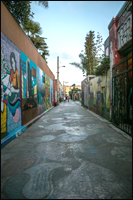One of CAMP’s most beloved and influential family members passed on November 4, 2021. CUBA, who was a part of CAMP from its beginning in the early nineties will be deeply missed by generations of family, friends, and followers.
Rest in Power CUBA, your spirit lives on through your powerful work and through the tens of thousands of younger and older artists you’ve inspired for four decades, and counting.

Thank you by Eleni Balakrishnan for the beautiful tribute:
‘Graffiti Godfather’ Cuba, who found his home in the Mission, dies at 57

Legendary Mission District graffiti artist Clarence “Cuba” Silas Robbs, a pioneer in graffiti writing known for bringing “Wildstyle” graffiti lettering to the Bay Area and painting hundreds of murals here, died on November 4. He was 57 years old.
On Thursday, Cuba’s fellow “Ex-Vandals” crew mates began painting a mural in his honor in Lilac Alley, where he and other alley “cats” could often be found painting the walls. Cuba painted the first mural in Lilac Alley in 2006 as the curator and co-founder of the Lilac Alley Mural Project, which eventually spread throughout other corridors in the neighborhood.
Cuba was also a curator of graffiti works for the Clarion Alley Mural Project since its start in the early ‘90s, and worked on projects with the Precita Eyes Muralists, teaching younger generations how to write graffiti during the annual Urban Youth Arts Festival. In spite of his reputation, fellow artists and friends remember him as humble and kind.
Though he loved the thrill of illegal graffiti, Cuba became a widely acclaimed artist, and was commissioned to do many legal works around the city. He worked on an 80-foot-long mural celebrating the San Francisco Giants and their World Series victory in North Beach, and painted the side of now-closed Revolution Cafe and an alley at the Mission National Bank.
But “he wasn’t just a graff guy,” said his friend Sam Gifford, a former roommate of Cuba’s who first met him at a Jerry Garcia Band show in 1984. “Cuba knew everybody, and everyone knew Cuba.”
He played music as a reggae DJ, and collaborated with Emory Douglas of the Black Panther Party.
“He was brilliant. He was profound and articulate, and he could wax poetic like no one I’ve ever met,” said Lisa Brewer of Mission Art 415, who worked on the Lilac Alley Project with Cuba. On any topic he was passionate about, Cuba was “a wealth of knowledge,” Brewer said.
Cuba was an influential part of the “Mission School” art scene and inspired well-known Bay Area artists like Barry McGee and Rigo 23, said visual artist Megan Wilson, of the Clarion Alley Mural Project. Cuba’s work was a form of activism, and he explored putting his art into books and manuscripts — his work is featured in collections at the Library of Congress, the New York Public Library, and various universities.
Not much is known about Cuba’s early life, but he was born in Baltimore on January 3, 1964 and grew up there. His mother was an herbalist who worked for a health food store and his father was “into home ’70s high fidelity,” as Cuba wrote in an illustrated autobiography.
As a young teen, he began to “escape the Baltimore public school system at every opportunity,” gravitating toward music festivals and arts on university campuses, Cuba wrote in the autobiography book series. Fed up with high school, he convinced his parents to allow him to attend the Baltimore Experimental High School, and managed to pay his way through as a cafe dishwasher.
Around that time, in 1979, he began noticing graffiti in Baltimore — “Seeing these strategically placed tags I knew instantly what an extremely powerful medium it was,” Cuba wrote. He began trying it for himself, and started using the name “Cuba” by May of 1980 at age 16.
Cuba became part of a small crew of graffiti writers involved in an underground punk-rock scene, and developed his distinct style during a time when graffiti was still seen as a criminal act.










